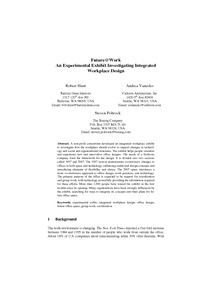Future@WorkAn Experimental Exhibit Investigating Integrated Workplace Design
Robert Hunt, Andrea Vanecko, Steven E. Poltrock
Publikationsdatum:
Zu finden in: Cooperative Buildings: Integrating Information, Organization, and Architecture (Seite 177 bis 190), 1998
|
 |
 Diese Seite wurde seit 4 Jahren inhaltlich nicht mehr aktualisiert.
Unter Umständen ist sie nicht mehr aktuell.
Diese Seite wurde seit 4 Jahren inhaltlich nicht mehr aktualisiert.
Unter Umständen ist sie nicht mehr aktuell.
 Zusammenfassungen
Zusammenfassungen
A non-profit consortium developed an integrated workplace exhibit to investigate how the workplace should evolve to support changes in technology and social and organizational structures. The exhibit helps people visualize and experience new and innovative office designs. The needs of a fictitious company form the framework for the design. It is divided into two sections called 1997 and 2007. The 1997 section demonstrates evolutionary changes to offices in both space and technology, enhancing traditional design concepts and introducing elements of flexibility and choice. The 2007 space introduces a more revolutionary approach to office design, work practices, and technology. The primary purpose of the office is expected to be support for socialization and group work, with technology powerfully providing the information required for these efforts. More than 1,000 people have toured the exhibit in the few months since its opening. Many organizations have been strongly influenced by the exhibit, searching for ways to integrate its concepts into their plans for future office space.
Von Robert Hunt, Andrea Vanecko, Steven E. Poltrock im Konferenz-Band Cooperative Buildings: Integrating Information, Organization, and Architecture im Text Future@Work (1998)  Dieses Konferenz-Paper erwähnt ...
Dieses Konferenz-Paper erwähnt ...
 Volltext dieses Dokuments
Volltext dieses Dokuments
 |  Future@Work: Artikel als Volltext bei Springerlink ( Future@Work: Artikel als Volltext bei Springerlink ( : :  , 108 kByte; , 108 kByte;  : :  Link unterbrochen? Letzte Überprüfung: 2021-03-21 Letzte erfolgreiche Überprüfung: 2019-10-11) Link unterbrochen? Letzte Überprüfung: 2021-03-21 Letzte erfolgreiche Überprüfung: 2019-10-11) |
 Anderswo suchen
Anderswo suchen 
 Beat und dieses Konferenz-Paper
Beat und dieses Konferenz-Paper
Beat hat Dieses Konferenz-Paper während seiner Zeit am Institut für Medien und Schule (IMS) ins Biblionetz aufgenommen. Beat besitzt kein physisches, aber ein digitales Exemplar. Eine digitale Version ist auf dem Internet verfügbar (s.o.). Aufgrund der wenigen Einträge im Biblionetz scheint er es nicht wirklich gelesen zu haben. Es gibt bisher auch nur wenige Objekte im Biblionetz, die dieses Werk zitieren.










 Biblionetz-History
Biblionetz-History